Three Chinese fashion graduates aim to develop their own style in New York
Three Parsons graduates are developing their own aesthetic. And New York is the place to do it, they tell Noor Brara

May and June are an interesting time for the fashion world, as the weather warms up and designers present their now ubiquitous resort collections.
The period also marks another presentation: that of just graduated designers about to enter the industry.
Regarded as one of the best design schools in the world, Parsons, The New School for Design has taught many famous figures, including Marc Jacobs, Tom Ford, Alexander Wang, Jason Wu, Lazaro Hernandez and Derek Lam.
It's no surprise, then, that Style.com and Kering collaborated with Parsons to provide students with the opportunity to showcase their thesis collections in "Empowering Imagination", a design contest that offers them the chance to present their thesis collections before a panel of experts.
Graduates compete for one of two winning spots that promise an internship at one of Kering's luxury brands, as well as personal mentorship from the editors of Style.com
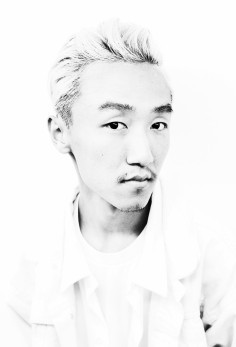
These represented a new breed of Chinese students making waves in New York: Mijia Zhang, Wenqi Wu and Ximon Lee. Three diverse designers with distinctive looks, although both Wu and Lee reference their Chinese backgrounds in their work, albeit in an abstract way.
Zhang, a native of Qingdao, and one of the more experienced designers in the running, was a winner alongside American student Justin Chu.
In addition to having interned at places like Vogue, Tabitha Simmons, Calvin Klein and Ralph Lauren, Zhang also recently won the Vogue Talents competition in Milan, after which her work was featured in the March and April issues of Vogue Italia.
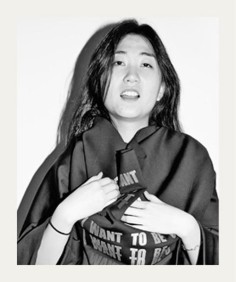
"It wasn't really interesting menswear either, just basic tailored suits, but to me that's really where my inspiration came from. That and hip-hop culture," she says, laughing. "So because of those influences, I've always been into the unisex, androgynous look."
Fittingly, Zhang's thesis collection was a unisex one, and was grounded in the study of high technology and how we interact with our fast-changing digital world.
"My own collection was inspired mainly by robots," she says. "I use a lot of hi-tech fabrics like neoprene. At the same time, I also have luxury fabrics and traditional furs. So the concept, as a whole, is to mix and match - to push boundaries with old fabrics and materials, and to give them new character.
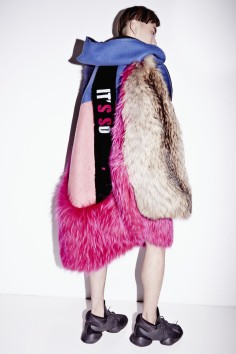
With avant-garde uses of fur in natural tones, as well as hot pinks swathed over expanses of coloured neoprene, Zhang's collection, which is made up of oversized sweatshirts, jackets, and biker shorts, is experimental and structured, playing with the dynamic between tradition and the future.
She credits Qingdao for her fun-loving aesthetic, and hopes to maintain her sense of humour. "My city has been really influential, because people are really good at taking in culture and absorbing different ideas about design. That has also allowed me to be good at looking, to be aware, and to keep my eyes open," she says.
Menswear designer Ximon Lee received a Special Honours nomination in the competition for his collection titled "Children of Leningradsky", which was inspired by his formative years spent in Manchuria and Hong Kong, as well as a recent trip to Russia.
After watching a documentary about homeless children that roam the streets of Leningradsky, a Moscow district, Lee decided to go to Russia to take pictures of how they lived and dressed.
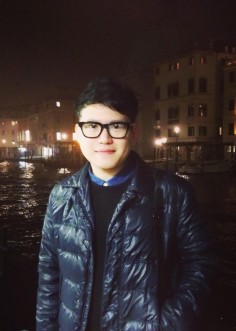
"I don't want to romanticise it, but I was attracted to how they would walk about the city like free spirits. I went to see how they dressed - they use what they can find, whatever's in the trash bins.
"Whatever fits, fits, and what doesn't just falls over their shoulders. So when they walk, all the layers flow together and form a dramatic shape."
These layers play a significant role in his collection, as he bonded inexpensive denims to make sturdier fabrics in different shades of white and blue.
Denim coats, wide-legged cropped pants and oversized hand-held accessories are few of the items that stand out, coming together as exaggerated forms of the silhouettes he had seen on his trip.
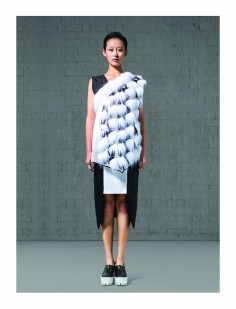
Zhang is in talks with Kering about where she will intern, and she hopes to find work in New York until that begins. Lee likewise hopes to find work in the city: "New York has the most diverse group of people," he says "This is definitely where I want to be."
Like Lee, womenswear finalist Wenqi Wu also addressed Chinese culture - but in an abstract way in his "Neo-Constructivism" collection. After growing up in Shanghai studying calligraphy, Wu moved to New York when he was 16 and began to take fine arts classes at school. He developed a particular fondness for the Russian Constructivists, and found interesting connections to his calligraphy in their work.
"When I was practising calligraphy, there were so many rules," he says. "If I'm mimicking the masters, I have to be very precise, and I feel like there's a similar precision in Russian Constructivism.
"I thought that was a great connection to explore for this collection, especially since modern art really represents New York to me. It's very graphic and focuses on lines and shapes in the same way Chinese calligraphy does.
"I wanted to work with those similarities instead of using clichéd Chinese motifs or images. I was trying to play with the boundaries of culture and modernism."
This comes through in his strict use of black and white fabrics, blazers and Oxford shirts with geometric details and prints inspired by Malevich and Rodchenko.
Like his peers, in the next few months he hopes to find work at a major fashion house in New York, and start entering design competitions. It seems that the lure of the Big Apple is as strong as ever for these students. [email protected]